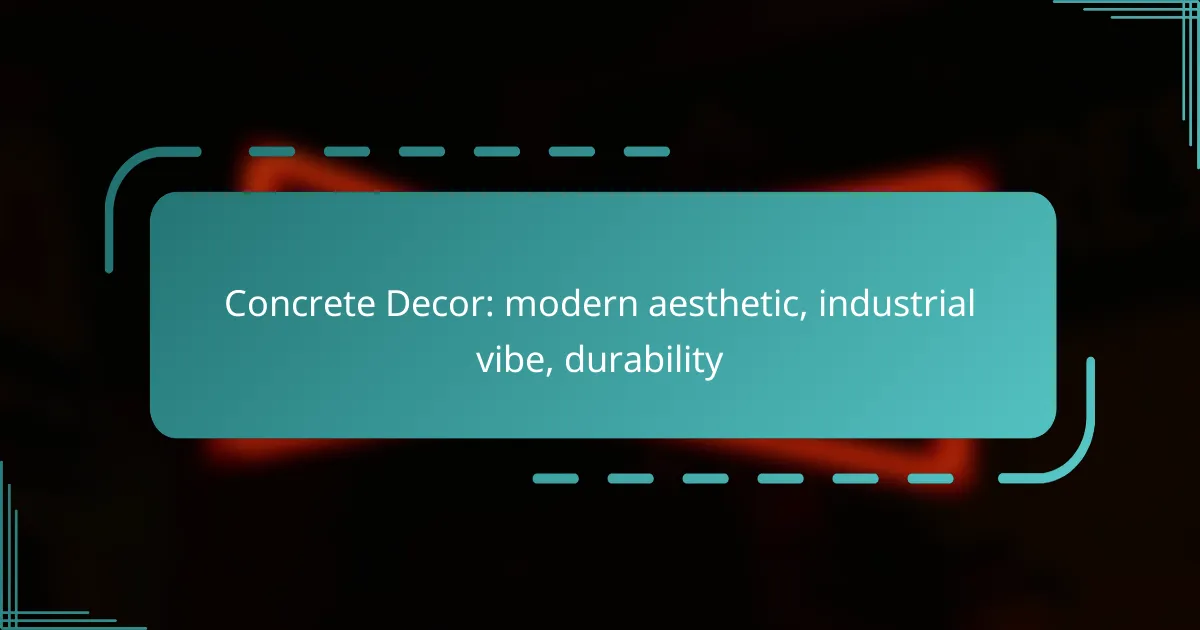Concrete decor seamlessly merges modern aesthetics with an industrial vibe, making it an ideal choice for contemporary spaces. Its raw, sleek appearance not only enhances visual appeal but also offers exceptional durability, suitable for both residential and commercial applications. From countertops to flooring, concrete elements provide versatility and creative expression while maintaining functionality.
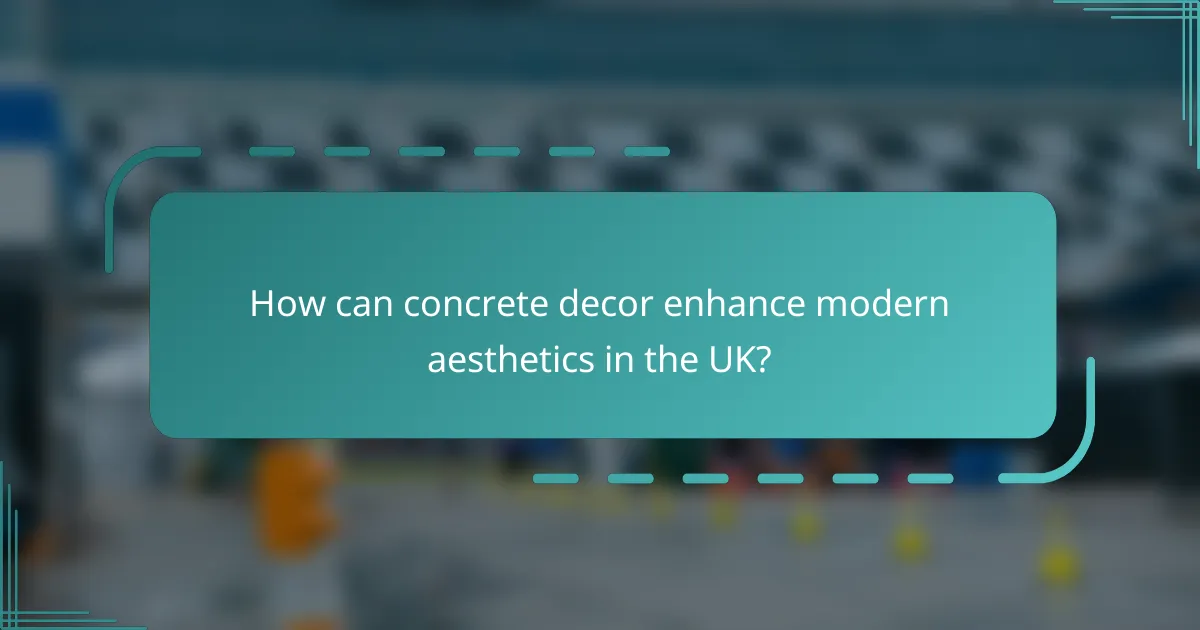
How can concrete decor enhance modern aesthetics in the UK?
Concrete decor can significantly enhance modern aesthetics in the UK by providing a sleek, industrial vibe that complements contemporary design. Its durability and versatility make it a popular choice for both residential and commercial spaces, allowing for creative expression while maintaining functionality.
Minimalist design elements
Concrete decor aligns perfectly with minimalist design principles, emphasizing simplicity and clean lines. By using concrete furniture or accents, spaces can achieve a streamlined look that avoids clutter, making them feel more open and inviting.
Consider incorporating concrete elements like tables, shelves, or wall art that serve as focal points without overwhelming the space. This approach not only enhances the aesthetic but also promotes a sense of calm and order.
Color and texture versatility
Concrete offers a wide range of colors and textures, making it adaptable to various design styles. From polished finishes that reflect light to rough, raw surfaces that add character, concrete can be customized to fit any modern aesthetic.
In the UK, you can find concrete products available in shades from soft greys to bold blacks, allowing for endless combinations with other materials. This versatility enables designers to create unique atmospheres that resonate with personal tastes.
Integration with natural materials
Concrete decor can seamlessly integrate with natural materials, enhancing its appeal in modern design. Pairing concrete with wood, stone, or plants creates a balanced aesthetic that highlights the beauty of both industrial and organic elements.
For example, a concrete countertop combined with wooden cabinetry can create a striking visual contrast while maintaining functionality. This combination not only adds warmth to the space but also reinforces a connection to nature, which is increasingly valued in contemporary interiors.
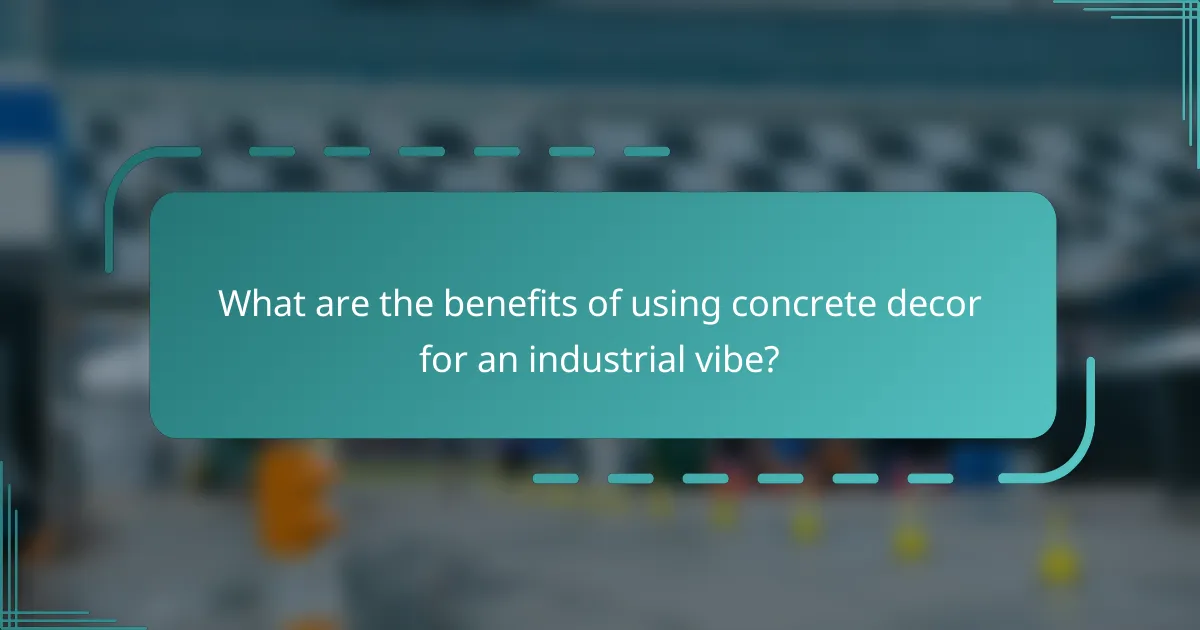
What are the benefits of using concrete decor for an industrial vibe?
Concrete decor offers a unique blend of modern aesthetics and an industrial vibe, making it a popular choice for contemporary spaces. Its raw appearance, combined with exceptional durability, makes it suitable for various applications, from residential interiors to commercial settings.
Raw and unfinished look
The raw and unfinished look of concrete decor enhances the industrial vibe of any space. This aesthetic embraces imperfections, showcasing the material’s natural texture and color variations. Incorporating concrete elements like furniture, wall treatments, or flooring can create a striking contrast with softer furnishings.
To achieve this look, consider using polished or stained concrete surfaces that highlight their innate beauty. Pairing concrete with warm wood or metal accents can further enhance the overall design while maintaining an edgy feel.
Durability and longevity
Concrete is renowned for its durability and longevity, making it an ideal choice for high-traffic areas. Unlike wood or other materials, concrete can withstand wear and tear, moisture, and even fire, ensuring that your decor remains intact for years. This resilience translates to lower maintenance costs over time.
When selecting concrete for decor, look for options that meet local building codes and standards. In general, well-sealed concrete can last several decades, making it a worthwhile investment for both residential and commercial spaces.
Easy maintenance
Maintaining concrete decor is straightforward, requiring minimal effort to keep it looking its best. Regular cleaning with mild soap and water is usually sufficient to remove dirt and stains. For outdoor concrete elements, occasional sealing can help protect against weathering and enhance longevity.
Avoid harsh chemicals that can damage the surface. If you notice any cracks or chips, prompt repairs can prevent further deterioration and maintain the aesthetic appeal of your concrete decor.
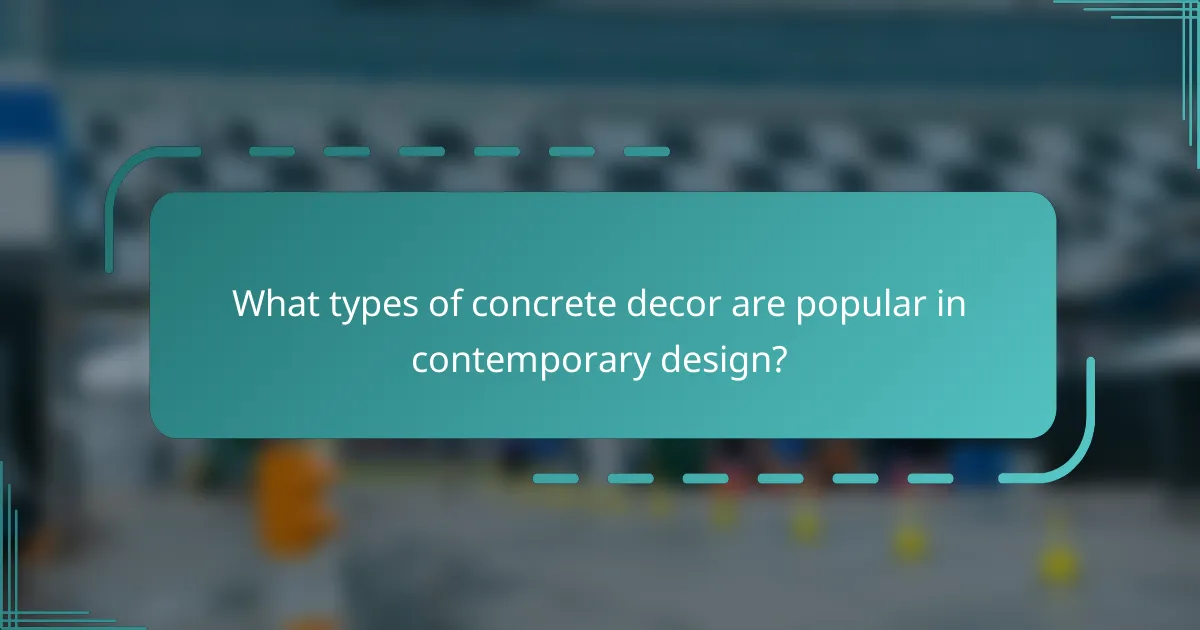
What types of concrete decor are popular in contemporary design?
Popular types of concrete decor in contemporary design include concrete countertops, flooring, and planters. These elements are favored for their modern aesthetic, industrial vibe, and durability, making them suitable for various interior and exterior applications.
Concrete countertops
Concrete countertops are a stylish and functional choice for kitchens and bathrooms. They can be customized in terms of color, finish, and shape, allowing for unique designs that fit any decor style.
When considering concrete countertops, it’s essential to think about sealing options to prevent staining and damage. A well-sealed countertop can last for many years, while an unsealed one may require more maintenance.
Concrete flooring
Concrete flooring offers a sleek, modern look that is both durable and easy to maintain. It can be polished for a glossy finish or stained for added color, making it versatile for residential and commercial spaces.
For those choosing concrete flooring, consider the insulation properties and potential for coldness underfoot. Adding area rugs or underfloor heating can enhance comfort while maintaining the industrial aesthetic.
Concrete planters
Concrete planters are increasingly popular for both indoor and outdoor gardening. Their robust nature allows them to withstand various weather conditions, making them ideal for patios and gardens.
When selecting concrete planters, ensure they have drainage holes to prevent water accumulation, which can harm plants. Additionally, consider the weight of concrete when positioning planters, especially for larger designs.
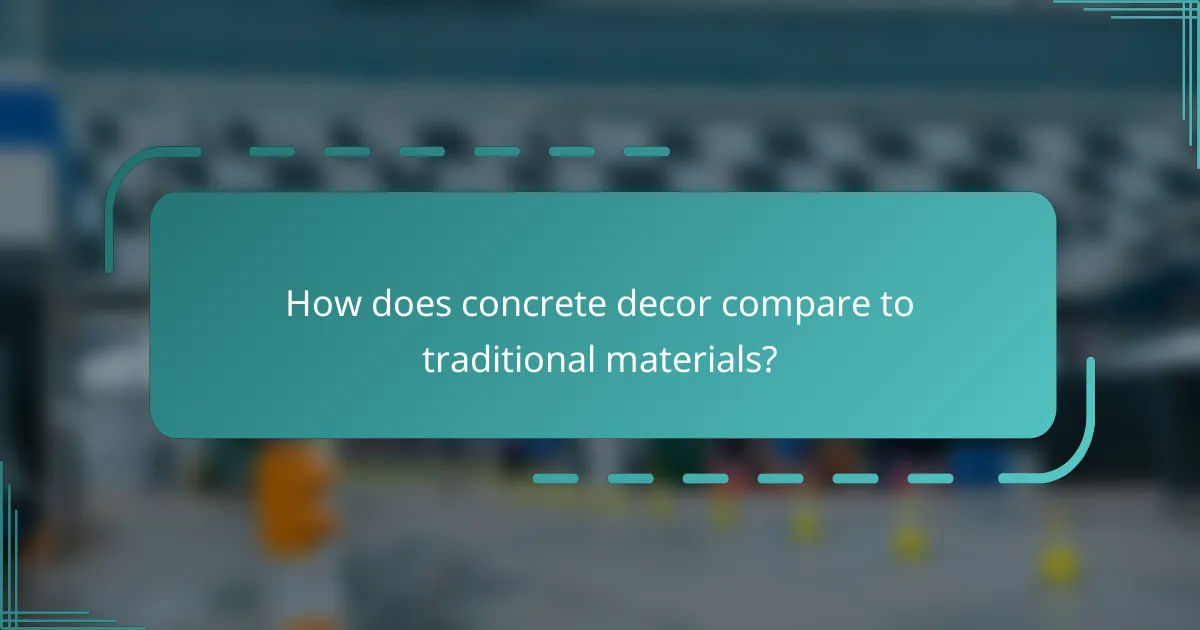
How does concrete decor compare to traditional materials?
Concrete decor offers a modern aesthetic and industrial vibe that sets it apart from traditional materials like wood or brick. Its durability and versatility make it a popular choice for both indoor and outdoor spaces, providing a unique blend of style and function.
Cost-effectiveness
Concrete decor can be more cost-effective than traditional materials in the long run. While initial installation costs may vary, concrete’s longevity and low maintenance requirements often lead to savings over time. For instance, concrete surfaces can last for decades with minimal upkeep, reducing the need for frequent replacements.
Additionally, the availability of concrete in various forms, such as pre-cast elements or poured-in-place installations, allows for flexibility in budgeting. Homeowners can choose options that fit their financial plans without sacrificing quality.
Environmental impact
The environmental impact of concrete decor is a significant consideration. While concrete production is energy-intensive, advancements in sustainable practices, such as using recycled materials and reducing carbon emissions, are improving its footprint. Many manufacturers now offer eco-friendly concrete options that adhere to green building standards.
Moreover, concrete’s thermal mass can enhance energy efficiency in buildings, helping to regulate indoor temperatures and reduce heating and cooling costs. This can contribute to lower energy consumption over time, making it a more sustainable choice.
Customization options
Concrete decor provides extensive customization options that allow for unique designs tailored to individual preferences. Techniques such as staining, stamping, and polishing enable homeowners to achieve various finishes and colors, making concrete suitable for any style, from rustic to contemporary.
Furthermore, concrete can be molded into different shapes and sizes, allowing for creative applications in furniture, countertops, and decorative elements. This level of customization is often more limited with traditional materials, making concrete a versatile choice for personalized decor.
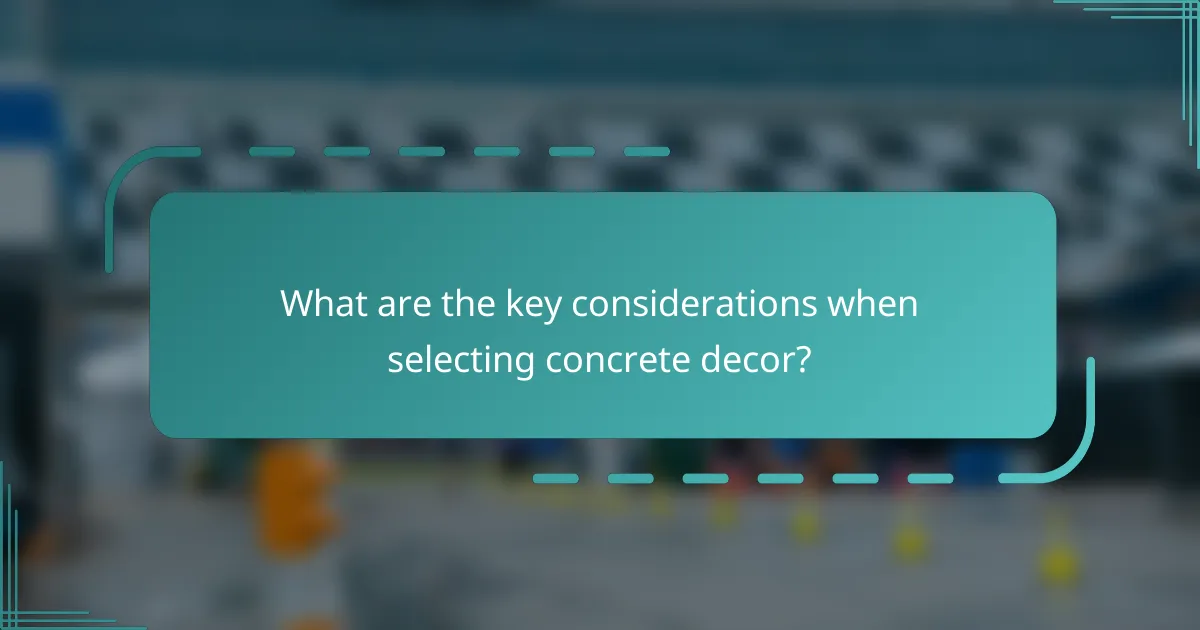
What are the key considerations when selecting concrete decor?
When selecting concrete decor, focus on style compatibility, durability requirements, and maintenance needs. These factors ensure that your decor not only fits your aesthetic but also stands the test of time and is easy to care for.
Style compatibility
Concrete decor can complement various design styles, from modern minimalism to industrial chic. Consider the overall theme of your space; for instance, raw, unfinished concrete works well in lofts, while polished finishes may suit contemporary settings.
To achieve a cohesive look, pair concrete elements with materials like wood or metal. This combination can soften the industrial vibe and create a balanced aesthetic.
Durability requirements
Concrete is known for its strength and longevity, making it a durable choice for both indoor and outdoor applications. It can withstand heavy use, moisture, and temperature fluctuations, which is particularly beneficial for high-traffic areas.
When selecting concrete decor, consider the specific environmental conditions it will face. For outdoor pieces, ensure they are treated for weather resistance to prevent cracking or fading over time.
Maintenance needs
Concrete decor typically requires minimal maintenance, but some care is necessary to preserve its appearance. Regular cleaning with mild soap and water can help prevent stains and dirt buildup.
For outdoor concrete, applying a sealant every few years can enhance durability and protect against the elements. Avoid harsh chemicals that could damage the surface, and always follow manufacturer guidelines for care.

How can concrete decor be used in outdoor spaces?
Concrete decor enhances outdoor spaces by providing a modern aesthetic and industrial vibe while ensuring durability. Its versatility allows for various applications, making it a popular choice for patios, walkways, and garden features.
Patios and walkways
Concrete is an ideal material for patios and walkways due to its strength and low maintenance requirements. It can be poured into various shapes and sizes, allowing for creative designs that complement the surrounding landscape.
Consider using stamped or stained concrete to add texture and color, mimicking natural stone or brick. This can elevate the visual appeal while maintaining the durability that concrete offers.
When planning a patio or walkway, ensure proper drainage to prevent water pooling, which can damage the surface over time. A slight slope away from structures is recommended for effective water runoff.
Garden features
Concrete can be utilized in garden features such as planters, benches, and decorative sculptures. Its robustness allows for intricate designs that can withstand outdoor conditions while providing a contemporary touch to any garden.
For planters, consider using concrete blocks or poured concrete to create unique shapes that enhance plant displays. Ensure drainage holes are included to promote healthy plant growth.
Incorporating concrete benches or seating areas can provide functional spaces for relaxation in gardens. Choose designs that harmonize with the overall aesthetic of the outdoor area, and consider adding cushions for comfort.
